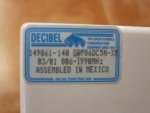JRBarrett
Member
Ahhh. . . I see. I hadn't thought of it that way. I thought the horizontal rods and the lower angled rods made up the groundplane and the whip was the main element. I understand better now. If the cone rods determine it's lower frequency is it then that the horizontal shorter rods determine its higher frequencies?
The upper and lower rods both determine the lowest frequency at which a discone will work. The lower rods should be one quarter wavelength at the lowest frequency, and the upper rods are 0.7 of a quarter wavelength.
I have a Diamond D130N discone. The upper elements are 22 inches across, and the lower elements are 32 inches long. That equates to a lower cutoff frequency of about 88 MHz. (Lower end of the FM broadcast band). I did not install the loaded whip on top as there is not a lot of low band activity around here.
Although you could cut the elements shorter to raise both the lowest and highest frequency a discone will work at, another variable is the width of the gap formed by the insulator that separates the upper disc from the lower cone. That gap is related to the lowest operating frequency, so if you simply cut the elements shorter, the antenna’s directional pattern would suffer.
If you want to do a lot of monitoring of 700-800 MHz systems, a second discone optimized for the higher frequencies would be the way to go.




